Rheinmetall RII
This is a very early Rheinmetall, right before they switched production to the new model Ib. Whereas the overall form factor of the machine stayed the same, a number of quite overdue changes were made to make the machines easier to assemble, work on and repair. Berk's 1922 design incorporated many good ideas, but also many which were plain bad. Its serial number is 5070, whch places it in 1928. There should be even earlier models which still have a full stepped drum per keyboard row, but this machine and its 5000 siblings already incorporated Berk's patent to use one stepped drum per two keybord rows.
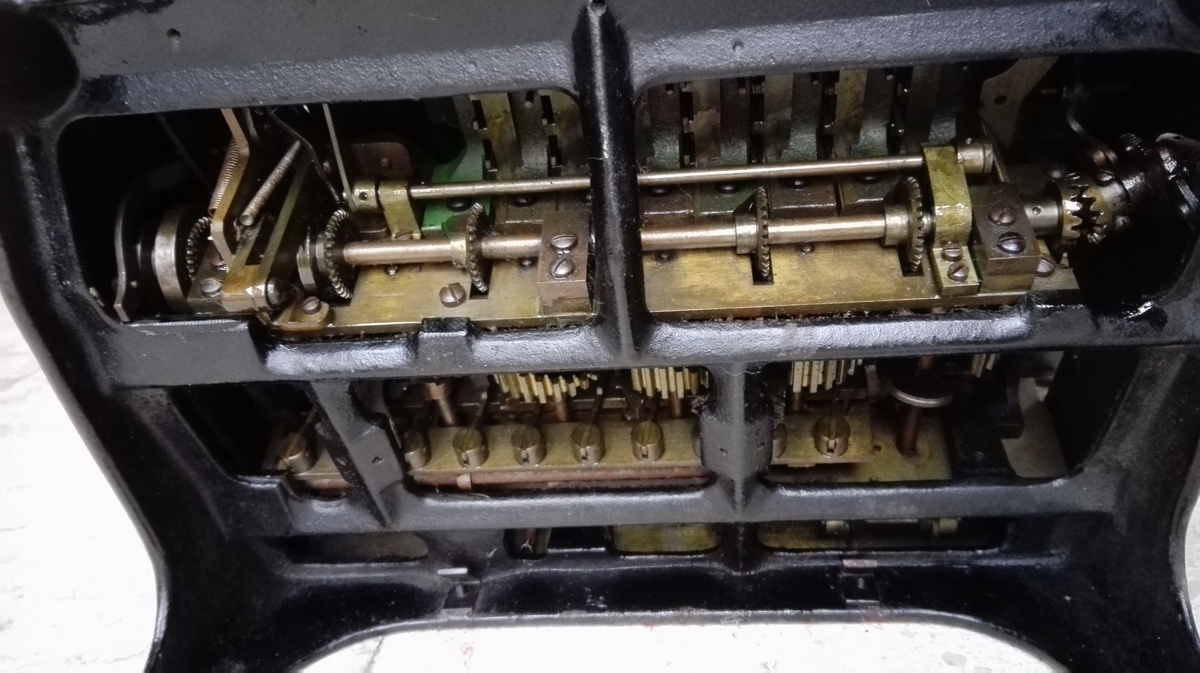
So what is different? For starters, the carriage movement. The carriage is spring-loaded through a drum with a fabric ribbon, that will tab it exactly one position to the left every time the "R" button is pushed. There is no star-wheel at the front yet for carriage movement. The carriage has to be pushed to the right by hand, and there is no way to release it except position-by-position. The machine makes very extensive use of springs, which tend to corrode and break, and cause all kinds of mayhem. This is especially bad in the keyboard, where every key has its own indvidual tiny spiral tension spring. If you look at the pictures, you can see the peg for hooking it to the right of every keystem. Now the real nightmare is to have to disassemble this keyboard, because the only thing that holds the keystems and springs in place is the next row of the keyboard to the left ... and for the leftmost row, a special cast "fake keyboard column". As soon as a keyboard row is disassembled (which has to be done with the machine lying on its righthand side, or you'll regret it in a hurry!), it is a ticking time bomb, just waiting to go "sproing" and jump apart completely . Later Rheinmetall machines have round keystems and are much easier to handle. Another example of a troublesome spring is the tooth that blocks the carriage movement during calculation. It is pushed up by an eccentric disc, into a square comb at the back of the carriage. But when the turn is completed, it should be pulled back down, again by a tiny, tiny spring. Luckily this spring was still whole, because it is impossible to reach without taking the riveted back off the frame. The tooth caused me lots of trouble though, because it was stuck enough for the spring to be unable to pull it back down, and then the carriage would refuse to move at all, in any direction. The screw that hold this toothed lever is impossible to reach with a screwdriver, and the back of it is peened to make sure it doesn't come out. It took a week of soaking in oil, and partly drilling out the screw from the back to free up the lever enough to be operational.
Well, more about this machine then. I got it from a retired engineer, whose father had been an engineer for the Belgian railways, and had rescued lots of calculators in the late 60s and early 70s, when they were going to the scrap heap. This led to a sizeable collection. The son, now in his 80s, decided it was time for downsizing because he "was unable to keep up with the maintenance". He took me to an attic where the entire collection was sitting, under the roof, and under the dust. I'm not sure what he thought "maintenance" involved on a mechanical calculator, but sitting in the filth for 30 or 40 years is clearly not what I would call "keeping up with maintenance".
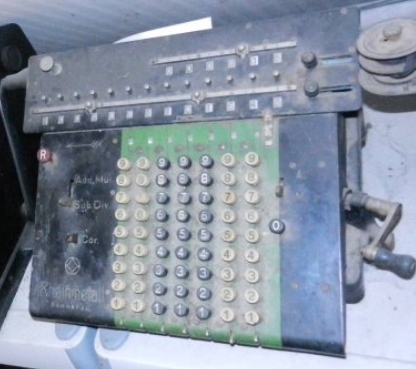
I rather think it should involve oil and grease, and perhaps operating a machine once in a while ... Every machine I looked at was completely filthy and totally blocked, and had clearly been so for decades. I ended up buying three of them, this Rheinmetall, and 2 Mercedes-Euklid machines - all blocked. When I got them home, it turned out that all three of them had been copiously infused with water at some point, and all of them were infested with rust. Water on calculator also does not equal "maintenance"... The two Mercedes-Euklids are probably terminal - I don't think I'll have the courage and time to try and rescue them. When I screwed the bottom plates off the true scale of the massacre came to light, with a pile of rust and what could be recognized as spiral spring parts falling out - it wasn't pretty.
Luckily, the Rheinmetall fared a bit better. The issue was that the carriage clearing mechanism as well as numerous result wheels were completely stuck - also, it turned out, due to rust. Weeks of penetrating oil succeeded in freeing the screws up enough to be able to undo them without too much damage, and I did manage to get everything apart, cleaned and lubricated. Of course this involved taking the keyboard apart to repair a number of springs and to lubricate it as well. This is why there are no pictures of the restoration - this type of keyboard is an accident waiting to happen, and I doggedly kept on working as carefully as I could to prevent things falling apart, until it was completely back together. I didn't even clean the top of the keyboard until it was safely back together. I also had to sew the drawstring back together for pulling the carriage to the left, and of course lubricate and clean all of the mechanism. It will probably never operate as smoothly as it did when it was new, but the machine is operational now. The only thing causing some difficulty is the "Correction" button, which does not always fully engage when pressed. I suspect it could be a spring, because it operates reliably when the machine is lying on its back. I may have to investigate some more ...
Now, on operation. The machine should always be cranked in the same direction. It has two levers - an "Add-Mul" vs. "Sub-Div" lever on the left, which switches the result register from positive to negative and back. The counter register has full tens' carry and always counts positively. The second lever is to the right of the keyboard and says "A - M". When set to "A" (addition), the keyboard is cleared after every turn of the crank.
So how do you subtract in the counter register ? That is what the correction button "Cor." is for (the red "C" button itself is missing in this machine, but you can see the stub). If this is pushed, the machine will switch the direction of what it is currently doing for one turn, and in addition will subtract in the counter register - so if you made one turn too many, either during multiplication or division, you can correct it in this way. The "R" button, as already mentioned, tabs the carriage to the left for a single position.
Here are some pictures of how the machine currently sits:
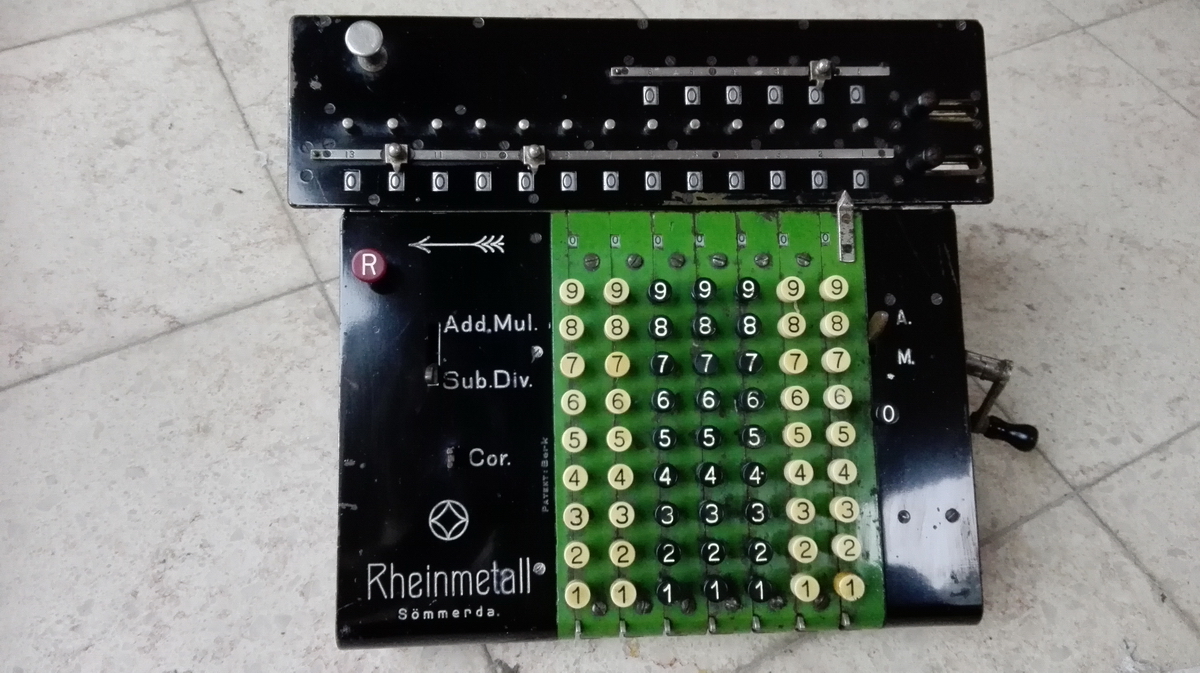
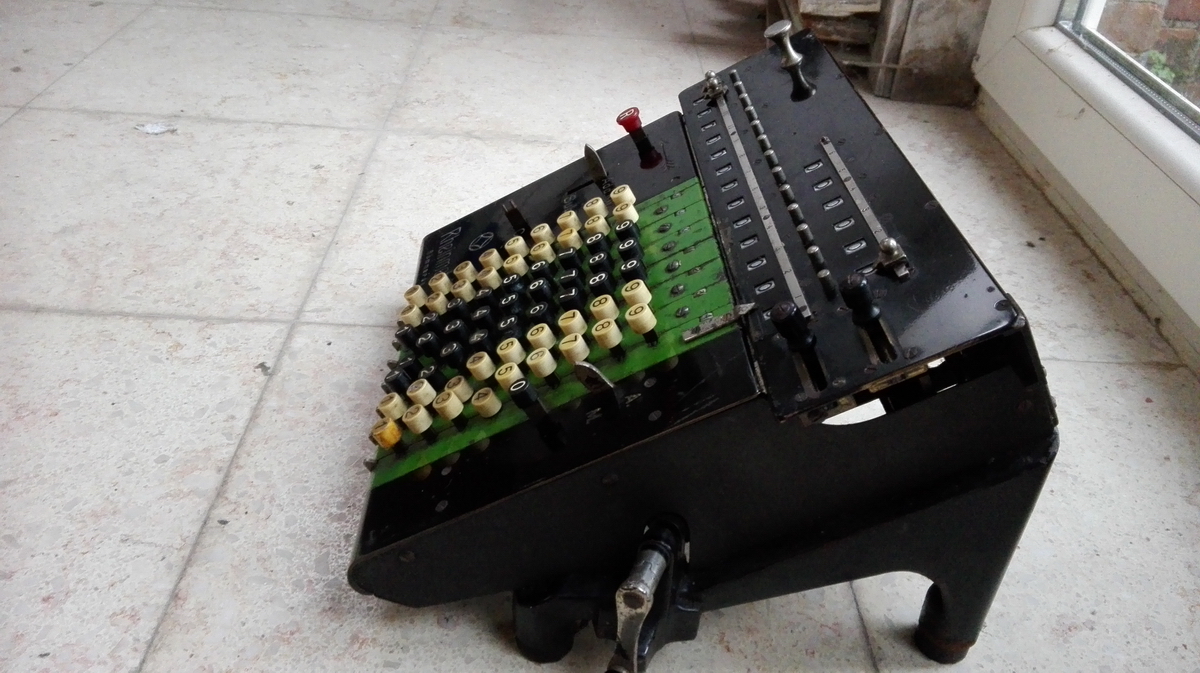
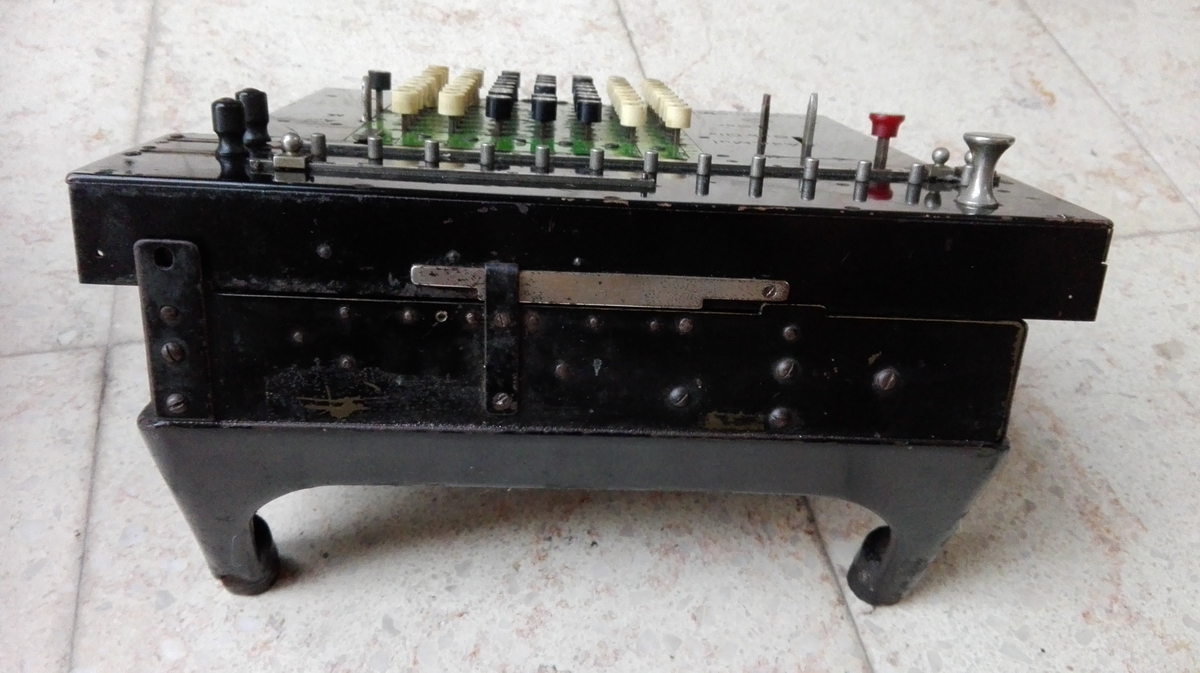
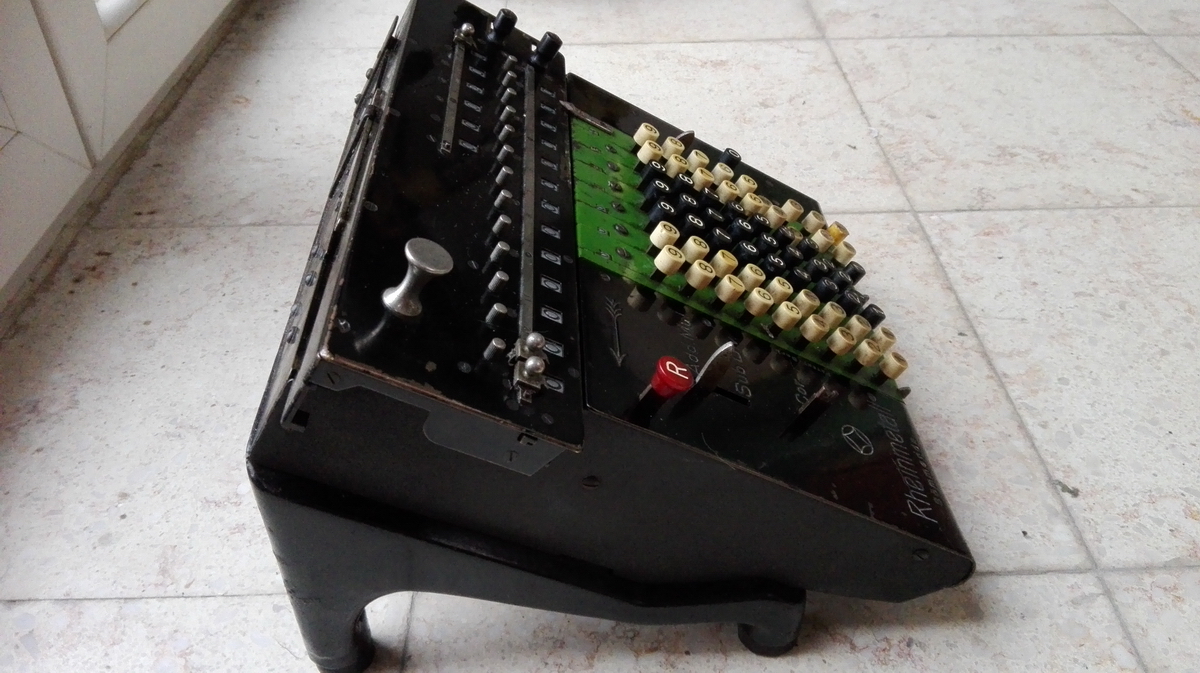
And here it is with a sibling that was visiting from someone else's collection, a Rheinmetall KEWS c. The family resemblance is quite clear, although every part in the base of the KEWS is substantially redesigned!
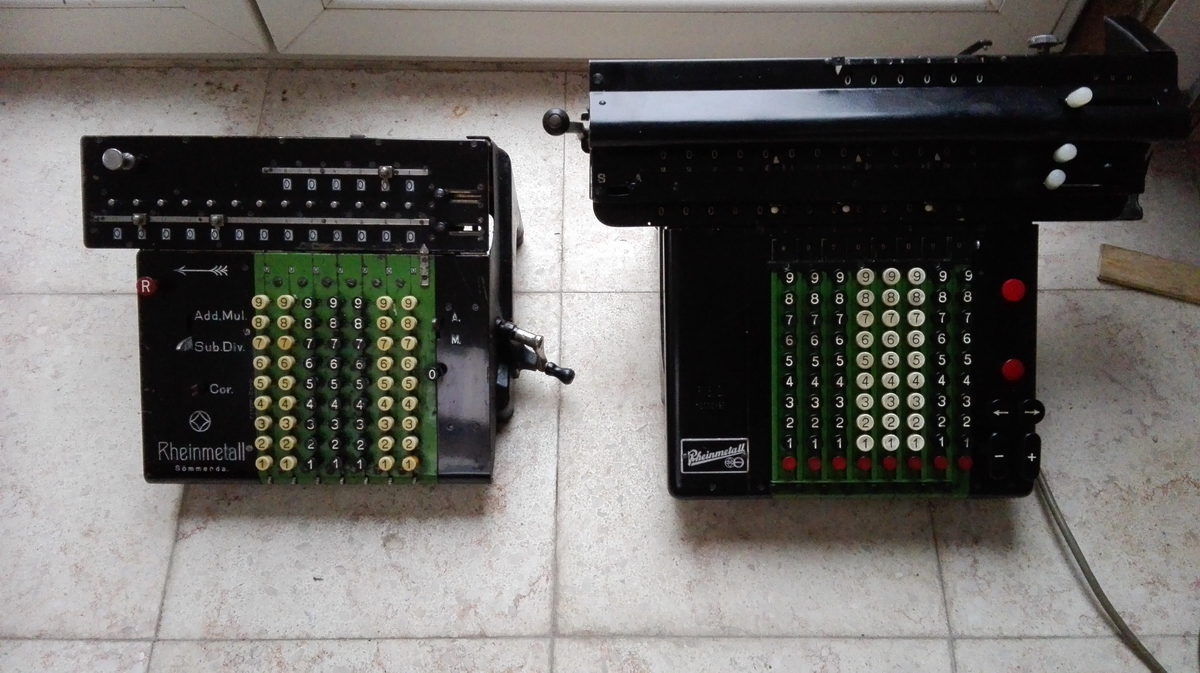
Rheinmetall AG, by the way, still exists, although they seem to have forgotten about their office machine history. Have a look under www.rheinmetall.com.
